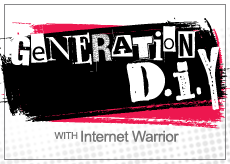Generation DIY: All About Recording
posted in: Features
 Over the years, pricey studios have catered to the big fish recording artist so the idea of home-based recording seemed pretty far-fetched. For newer artists, the questions of who to record with, what studio to use and is there a cheaper and easier way to record are vital. But, in today’s do-it-yourself climate, conventional thoughts about going into a studio to work with a producer/engineer in order to create that first album or EP are rapidly changing. This is Generation DIY and we’re all about taking control, remember? So let’s take a few minutes to talk about ways you can record on your own and still get that nice studio quality sound.
Over the years, pricey studios have catered to the big fish recording artist so the idea of home-based recording seemed pretty far-fetched. For newer artists, the questions of who to record with, what studio to use and is there a cheaper and easier way to record are vital. But, in today’s do-it-yourself climate, conventional thoughts about going into a studio to work with a producer/engineer in order to create that first album or EP are rapidly changing. This is Generation DIY and we’re all about taking control, remember? So let’s take a few minutes to talk about ways you can record on your own and still get that nice studio quality sound.
Our generation has been blessed by the innovations of many visionaries within the music industry. The idea of recording, mixing and self-producing an album in the comfort of your own home baffled the big shots who thought it would never work out. Obviously, we have the Internet to thank. A quick Google search yields many Web sites and PDF documents on how to record using all the little tricks engineers know.
The release of programs such as Pro-Tools, CakeWalk, Cubase, Logic, (not to mention preloaded Garageband on Mac computers) has enabled this the wave of home-based studios taking over the recording industry. Aspiring artists can purchase any of these programs from stores like Guitar Center, Daddy’s Junky Music, Sam Ash, Apple, and, of course, the web. Well Mr. Warrior, studios have those big ass mixing boards and ¦ well how do you plug your guitar or microphone into your computer? you ask. Good question. I see you’ve done your homework (of course you did, it’s Gen DIY’s Number 1 rule: research). This is a very easy and quite affordable fix. Check Musicians Friend or your local music shop (Guitar Center, Sam Ash, Daddy’s etc) to find recording interfaces such as M-Audio, PreSonus, Focusrite etc. These are either USB or Firewire connected and will generally work with any digital audio workstation (DAW) which is your Logic, Pro Tools, Garageband and so forth.
Along with these programs and devices, there are many online tutorials which can aid you in the process of recording and mixing down. Honestly, my one suggestion is to take your raw files (once you are able to record some decent tracks) to an engineer to mix (i.e. turn into gold) at a studio. This will cut out the cost of recording, which is the biggest chunk of time that can be wasted in a studio. For those of you that want to do it yourself without any help, I salute you! Processors for compression and effects as well as good software for recording vocals are great tools to add to your home studio. As for vocals, the Antares software, as well as Melodyne, seem to be a favored pieces of software used by many studios. Remember, there is a lot to learn and it won’t happen overnight. Give yourself time and have patience when working with these programs, the more time you take the better the outcome.
Just like always doing your research, asking around to see what other musicians are using is a great way to figure out which hardware/software will work best for you. For you rock fanatics out there, Pro Tools may be a great fit for software. However, the hip hoppers may want to focus on drum machines and loop machines for their hardware. Currently, OurStage is promoting the Beat Kangz Beat Thang which is a great tool in terms of creating instrumental tracks. Really, there’s something out there for everyone so do your homework before you commit. Even if $250-$400 doesn’t seem like a whole lot, it’s still an investment and you want the best output for your work.
Hopefully you get the idea and are able to choose the right home studio path. If you have questions, you can always leave a comment and I’ll do my best to help you get you on your way.
Keep that hustle strong Generation DIY. This is YOUR year!
